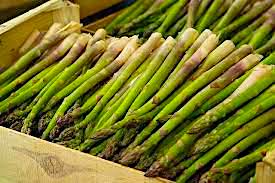
~ Press release issued by Virginia Farm Bureau Federation
WASHINGTON — April means asparagus…one of the spring’s most venerable vegetables…has arrived. Typically harvested in early April through May, the spears develop daily from undergrown crowns and can grow stems as tall as 5 to 8 inches aboveground. Asparagus is a hardy perennial plant that can live from 12 to 15 years.
Among the most valuable of the early spring vegetables, asparagus can be traced back to 3,000 B.C. Archeologists believe the ancient Egyptians and other early civilizations cultivated the plant for medicinal purposes.
Today, asparagus has naturalized over much of the eastern U.S. and can be found in gardens, fencerows and along roadsides. Preferring well-drained loam soils and tolerable winters, asparagus is well-adapted to most areas of Virginia.
In the commonwealth, 190 farms harvested asparagus on 176 acres in 2017 — up from 105 farms on 85 acres in 2012, according to the most recent United States Department of Agriculture Census of Agriculture findings.
A 2021 USDA summary reported 17,000 acres of asparagus for fresh market were harvested nationally — a decrease from 20,400 acres in 2019. Slowed production in the U.S. can be attributed to COVID-19 and the labor market, according to Market Data Forecast.
But global demand for asparagus is on the rise, according to a 2023-2028 Market Data Forecast that also reported the market is dominated by U.S. farmers. This is primarily due to growing consumer health consciousness, as certain nutrients and compounds in asparagus offer significant health benefits.
Rich with vitamins, antioxidants, minerals and fiber, asparagus accounts for a significant portion of daily nutritional needs and is believed to help lower blood pressure, protect against various chronic diseases and support a healthy pregnancy.
Mike Cullipher, a Virginia Farm Bureau Federation Specialty Crops Committee member, has been growing asparagus on his Virginia Beach farm for about 16 years. After picking the season’s first strawberries last week, he is now starting to harvest asparagus.
“We’ve had a few warm days the past few weeks, but overall it’s been fairly cool — just about ideal growing conditions for asparagus, so it looks like it will be a good year,” Cullipher said.
Large-scale asparagus production is uncommon in Virginia, he said, and most farmers grow about 4 acres or less as a secondary crop. Cullipher uses the short, five-week harvesting season to generate early cash flow after October’s pumpkin season. The weeks in between, he said, are “a long time to have no revenue.”
He said consumers may see higher prices for locally grown asparagus this season and attributed that to higher production costs for small-scale Virginia farmers, labor-intensive harvesting and other factors.
For home gardeners, Virginia Cooperative Extension recommends starting asparagus from seed or from 1- to 2-year-old crowns purchased from a reputable nursery. Seed may be started in peat pots and transplanted in the summer, either to a final growing site with good drainage and full sun or a temporary transplant bed.
For more growing tips, visit ext.vt.edu.
To find fresh Virginia asparagus near you, visit the Virginia Grown website at vdacs.virginia.gov/vagrown/index.shtml.
•••
RELATED ARTICLES
Animal Welfare Institute calls Pine Grove poultry fire ‘second-most devastating’ in country
County commits $300K to Phase II efforts for creating a meat processing facility in Page
New report shows number of Virginia farms and farm acreage remained steady last year
Skyrocketing temperatures leave budding fruit trees vulnerable to frost



Be the first to comment